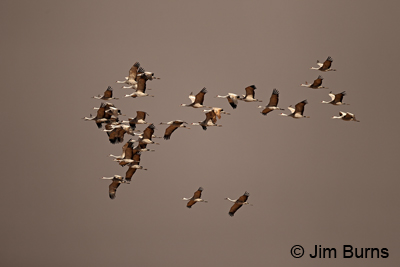
The winter grasses are limned in burnished copper, rim lit by a thin sun struggling up over the Chiricahuas to the east, bright against the pewter clouds roiling up over the Mule Mountains in the west, presaging the impending snowstorm. Southwest winds abet temperatures in the low twenties and send boulder-sized tumbleweeds careening down the draws. A roadrunner, disdaining to take wing as it defies death-by-vehicle, skitters across the dusty dirt road, avoiding my front bumper seemingly by inches.
This is the Sulphur Springs Valley, J. A. Jance’s high lonesome, where Sandhill Cranes outnumber the people from November through February, and the austere beauty of the classic Western landscape is broken only occasionally by the crumbling adobe of abandoned homesteads. This valley is an Arizona hotspot in winter for birds of prey that come, like the cranes, because the living is easier here this time of year than on their snow and ice covered breeding grounds farther north. It’s a different living, of course, the cranes coming for the corn, the raptors with blood on their beaks.
I come to Whitewater in winter for the hawks, not the cranes. For Sandhills I go to Bosque Del Apache National Wildlife Refuge in central New Mexico. The Bosque has more area, more corn, more cranes, and the wildlife drive there completely encircles the main Sandhill loafing area, providing great photo ops at some point in the day no matter the direction of the light and the wind. But the Bosque does not have the variety and numbers of hawks typically found at Whitewater where the smaller area seems to compress them and make them easier to find and view.
Compared to the Bosque, the Whitewater refuge itself is a postage stamp with no roads, just an entrance driveway leading to a path and two overlooks directly south of the cranes’ ponds. Usually at Whitewater I ignore the cranes and drive the farm roads watching the fenceposts and utility poles. Today is different, though. Twenty-two thousand cranes are circling and milling about, undoubtedly ill at ease before the coming weather drama, many utilizing fields on or much closer to the refuge rather than winging northward to far flung areas, some sixty miles away on the other side of Interstate 10.
Both near and in the far distance, skeins of Sandhills stream across the leaden snow clouds showing, then disappearing, as they wheel and bank, forming and reforming, the lighter plumage of cheek patches and necks glowing, then flickering out against the stormy, gray background. I am transfixed by the kaleidoscope of changing colors and forms wrought by the weather, privately embarrassed to realize I have never taken a single crane photograph here, exquisitely frustrated knowing the camera cannot capture what my eye is seeing.
If you’ve never been to the Bosque in winter, it has to be on your North American bird bucket list, one of only a handful of true natural spectacles our continent can claim. If you can’t make it next winter, check out Whitewater instead. It’s the Bosque on a smaller scale. It’s a must see part of Arizona’s natural heritage. Dress warmly.
